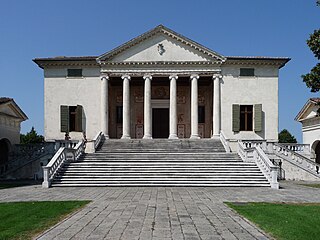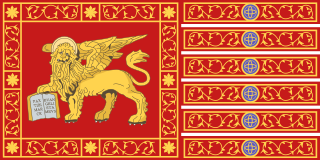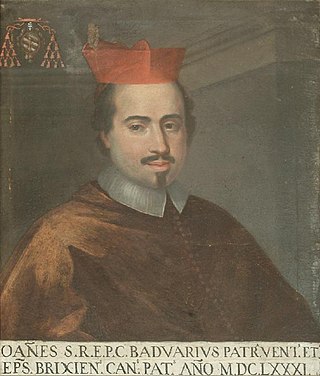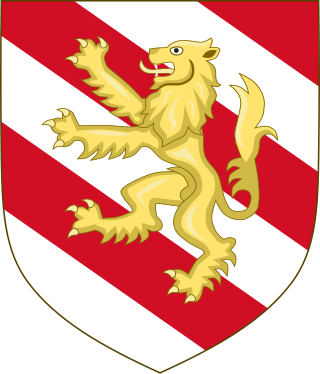Giacomo Badoer may refer to:
- Giacomo Badoer (fl. 1403–1442), Venetian merchant
- Giacomo Badoer (c. 1457 – 1537), Venetian administrator
- Giacomo Badoer (c. 1575 – c. 1620), French diplomat
- Giacomo Badoaro (1602–1654), Venetian poet
Giacomo Badoer may refer to:

Villa Badoer is a villa in Fratta Polesine, in the Veneto region of northern Italy. It was designed in 1556 by Italian Renaissance architect Andrea Palladio for the Venetian noble Francesco Badoer, and built between 1557 and 1563 on the site of a medieval castle, which guarded a bridge across a navigable canal. This was the first time Palladio used his fully developed temple pediment in the façade of a villa.

Luca Badoer is an Italian former racing driver. Badoer has raced for the Scuderia Italia, Minardi, Forti and most recently, Ferrari teams. In addition to his racing duties, Badoer was one of the active test and reserve drivers for Ferrari from 1998 to 2010 and in 2009 stood in for Ferrari's regular race driver Felipe Massa at the European Grand Prix and the Belgian Grand Prix after the Brazilian was injured during qualifying for the Hungarian Grand Prix and his original replacement, Michael Schumacher, pulled out due to injury.
Bajamonte Tiepolo was a Venetian noble, great-grandson of Doge Jacopo Tiepolo, grandson of Doge Lorenzo Tiepolo, son of Giacomo Tiepolo. Bajamonte's wife was the Princess of Rascia. Marco Querini, a fellow conspirator, was his father-in-law.
Giacomo Badoaro (1602–1654) was a Venetian nobleman and amateur poet. He is most famous for writing the libretto for Claudio Monteverdi's opera Il ritorno d'Ulisse in patria (1640). He also provided librettos for the operas Ulisse errante by Francesco Sacrati (1644) and Elena rapita da Teseo (1653) by Jacopo Melani. He was a member of the Venetian intellectual circle, the Accademia degli Incogniti.

The Accademia Veneziana was an Italian learned society active in Venice from 1557 to 1561. It was founded by Federico Badoer and shut down by the Venetian government.
Giacomo Badoer was a French-born diplomat, of Venetian parentage, and pupil of Galileo Galilei.

San Lio is a church located on the campo of the same name in the sestiere of Castello.

The aspron, from Latin asper, was a late Byzantine name for silver or silver-alloy coins.

The island of Cyprus was an overseas possession of the Republic of Venice from 1489, when the independent Kingdom of Cyprus ended, until 1571, when the island was conquered by the Ottoman Empire.
Andrea Biagio Badoer was a Venetian administrator and diplomat.

Giovanni Alberto Badoer or Gianalberto Badoaro was a Venetian Catholic cardinal who served as Patriarch of Venice and Bishop of Brescia.
Giacomo Badoer was a Venetian merchant known for his surviving account book, the Libro di conti.
Federico Badoer (1519–1593) was a diplomat of the Republic of Venice whose career was derailed in the 1560s by debts and unauthorized diplomacy.

The Badoer were an aristocratic family in the Republic of Venice. The Badoer traced their ancestry, without any factual basis, to Doge Giustiniano Participazio in the early 9th century. In fact, they rose to prominence in the 13th century.
Giovanni Badoer or Zuan Badoer was a poet, politician and diplomat of the Republic of Venice.
Sebastiano Badoer was a Venetian patrician, diplomat and humanist. He served as ambassador four times to the Holy See, thrice to Milan and once each to Naples, Hungary, France and the Empire. He left behind few writings but ample testimonies of his learning.
Giacomo Badoer or Jacopo Badoer was a merchant and administrator of the Republic of Venice.
Alvise Badoer was a Venetian patrician, lawyer, administrator and diplomat. He played a major role in the Ottoman–Venetian War of 1537–1540. He advocated for and helped arrange the Holy League in 1537–1538, took command of Venetian Dalmatia in 1538–1539 and negotiated the peace treaty in 1540.
Francesco Badoer was a Venetian patrician, politician and diplomat.

Donata Badoer was an Italian noblewoman from the Republic of Venice.